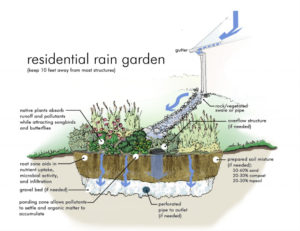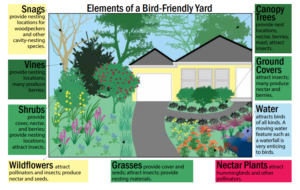Native Plant Gardens
Last Saturday MUCC’s OTG program planted 275 shrubs and trees at Potterville SGA. Currently, the area is being managed for wetlands. American hazelnut, buttonbush, highbush cranberry and two dogwood varieties were planted across 8 acres in the SGA. Besides bringing the area closer to its goal, the species planted are utilized by wildlife. Not only do these plants provide food for pollinators and other wildlife, but they also provide shelter. Overall making the area great habitat for pheasants, waterfowl, turkey, rabbits and other non-game-related species.
This technique of creating an optimal habitat for wildlife is not restricted to State Game Areas and can be utilized in your own backyard. Here are some native plant species that will optimize the habitat on your property.
Pollinator Garden-
Pollinators such as bees, butterflies and hummingbirds are vital components of ecosystems. Pollinator gardens are designed to support and promote their populations. Proper plants to use can differ based on region and it is suggested to avoid using hybrid varieties. The flowers should bloom from early spring to late fall. Including night-blooming plants in the garden will support pollinating bats and moths. Along with flowering plants, larval host plants should be included. This will support a different stage of the pollinator’s life cycle.
Some examples of plants to include in pollinator gardens are cardinal flower, wild bergamot, eastern columbine, beardtongue foxglove, orange butterfly milkweed, golden alexander, wild geranium, calico aster, great blue lobelia, black-eyed Susan, evening primrose, phlox, Silene catchfly and fleabane.
These plants can be found on the Garden for Wildlife website as well as in multiple county conservation districts’ annual plant sales.
Besides planting proper flora putting in bee houses, hummingbird feeders and butterfly feeders will help make the most of the garden. If you would like to find out more about pollinator gardens click HERE.
Rain Garden-
A rain garden helps to channel water and recharge groundwater. This can limit pooling and water runoff. If your property is near a water body or wetlands, having a rain garden will limit the number of pollutants entering the area, reduce erosion and create diverse wildlife habitats. A rain garden should be located 10 ft. away from any infrastructure and in the path of consistent runoff. Typically rain gardens can be found in basins or in low areas. Making rocky paths or vegetative swales will lead runoff to the garden. The proper garden construction and soil composition is described in the figure.
 Some plants that can be used are nodding wild onion, smooth aster, ostrich fern, wood poppy, compass plant, winterberry, rose mallow, palm sedge, blue flag iris, redbud, sweet gale, bur oak and spicebush. For a more complete list of rain garden plant varieties and where to buy them click HERE.
Some plants that can be used are nodding wild onion, smooth aster, ostrich fern, wood poppy, compass plant, winterberry, rose mallow, palm sedge, blue flag iris, redbud, sweet gale, bur oak and spicebush. For a more complete list of rain garden plant varieties and where to buy them click HERE.
Bird-Friendly Landscape-
A bird-friendly landscape design is not just great for birders; this garden design helps to reduce pests. This area works by promoting nesting. The different plant types present create optimal habitats for birds and give them multiple resources for nest building. While feeding chicks and themselves, the birds eat large amounts of pests in the garden, reducing the number of pesticides needed. Other wildlife benefits from the design as well, the diverse plant life provides many different types of habitats.

A bird-friendly garden includes trees, vines, shrubs, wildflowers and grasses. Some native species that can be used are black cherry, white oak, red maple, chokecherry, pasture rose, wild bergamot, purple coneflower, big bluestem, switchgrass, creeping juniper, bearberry, boneset and jewelweed. More information on the bird-friendly garden structure and plant species can be found HERE.
Plant varieties can be found in county conservation districts native plant sales and native plant growers across the state.
Adapting private land doesn’t only improve wildlife habitat it also will relieve the stress of dealing with non-native plant varieties. These gardens, once established, need less water, pesticides, and fertilizer compared to hybrid plants. Also, they can improve the land by reducing erosion and limiting the pooling of water. More information on native plant growers can be found HERE.
The post Native Plant Gardens appeared first on Michigan United Conservation Clubs.



